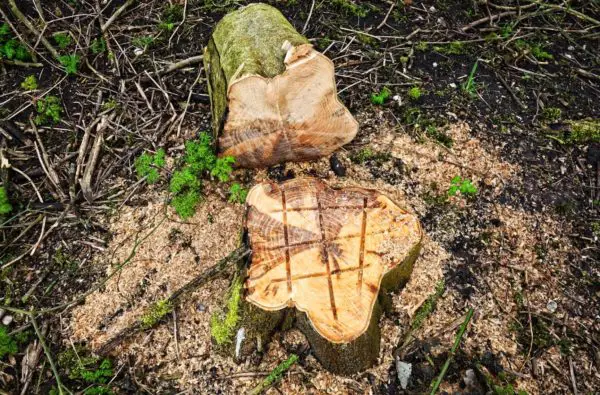Working with a handsaw is not as hard as it’s labeled. This hand-operated tool is among the most frequently used in gardening and woodworking. If felling a tree is among your current needs, the safest tool for this task is a handsaw. Bear in mind that when you trim branches and cut down trees, they will definitely give in to gravity in a quite unpredictable manner, meaning you’re going to need to avoid standing in the way.

With that being said, although cutting down trees is a fairly straightforward task, there are certain aspects to remember if you want to stave off the potentially dangerous mistakes. Keep reading this post and then switch to BumperCropTimes for some more handy tips on how to cut down trees using a handsaw.
Tip 1: Get Ready in Advance, for Preparation is Key
First and foremost, ensure that the tool has sharp teeth. You can sharpen your handsaw’s blade either with a grinding machine or a metal file. Alternatively, you can always ask a pro for assistance in this matter. Using a handsaw with a rusty blade may result in you breaking it.
Then, if you want to cut down trees with a handsaw safely, always focus on holding the tool from the grip handle. Furthermore, when utilizing a handsaw, avoid applying excessive pressure with your hand onto the blade. Otherwise, you may hurt yourself in the long run. Before you start cutting a tree with your handsaw, don’t forget to put on safety goggles for eye protection, along with a helmet, and kevlar chaps.
Tip 2. Know Your Steps Like a Pro
Start by trimming the tree’s branches. Let the top hefty branches become your utmost priority — get rid of them first. Because the branches you’ll cut will fall down fast and unexpectedly, using an orchard ladder is paramount. Also, make sure you focus on cutting branches from above first and never start from the ground level.
If you want the whole process to be as safe as possible, ask a buddy to hold the ladder for you. That is, if falling down from the ladder and breaking your neck is not among your utmost priorities. Use the tool in quick and firm strokes for dealing with the branches. When you reach the last inches of a branch, light down your strokes to prevent the branch from breaking. Once you’re through with the brunches, clear up the ground, for that’s where you’ll be cutting down the tree trunk.
Tip 3. Approach Cutting Down a Tree Trunk Wisely
When you’re finished cutting down the tree’s branches and clearing up the ground, concentrate on the trunk. The wisest (and safest) approach here is cutting the tree trunk in the direction it leans to, at approximately six inches from the ground. Start by firmly and steadily cutting a triangular section out of the trunk in the direction you need the tree to fall. This adds up to the safety of the affair greatly, for that way, you control the direction where the tree will fall.
Fell a Tree Safely Using a Handsaw: More Tips
Cutting down trees is potentially dangerous, that’s a fact. If you don’t follow the safety measures and techniques provided in this post, you may end up hurting yourself or others. You’ve already discovered that to safely fell a tree with a handsaw, you need to clear up the area near the tree and ensure that there’s a clear, safe path for the tree to fall. Find some more hacks on cutting down trees safely below:
- know the rules: in certain states, you’re going to need to get a permit before cutting down a tree, so make sure you check with with the local officials regarding this issue in the first place;
- examine the soon-to-be-cut-down tree for stability: ensure that the tree you’re focused on is healthy, because if it’s not, the cut-down process may result in multiple unpredictable and dangerous situations;
- plan an escape path: as a final preparation step, plan out the safest walk-in path as the tree is falling. Avoid standing or walking in front or behind a falling tree.
Answering Your FAQ About Felling Trees With Handsaws
Have questions left about cutting down trees with a handsaw? I’ve answered some of my readers’ most frequently asked questions on the topic below. Take a browse through my answers, perhaps some of them resonate with your current questions. If they don’t, drop me a line via BumperCropTimes and I’ll get back to you ASAP.
Will my handsaw cut all kinds of wood?
Not necessarily. Of course, using a handsaw that’s purposely made to cut the type of wood you need is preferable. However, sticking with a reliable, well-made, and wisely-bought multi-purpose tool is also a good option.
Two handsaws are similar in design and functionality. How can the price tag on them be so far apart?
Figuratively speaking, if you want a Honda, you pay the Honda price. But if Porsche is your ultimate goal, you pay the Porsche price. Typically, a higher quality handsaw costs more money compared to a generic one.
Why do blades differ in length?
That’s because they’re made to cut trees and branches of various sizes. Naturally, you’re going to need longer blades to cut down heftier branches and trees.
Cutting (Down) to the Chase
Felling trees with a handsaw is relatively safe, but only if you know how to do it — and if you’ve practiced the whole thing more than once (and survived). Don’t forget that getting a reliable handsaw is also vital when it comes to cutting down trees safely. You can always count on me whenever you have questions or need advice on the topic. BumperCropTimes.com is where you can find me and get the expert-backed discussion going. See y’all there and always put safety in the first place when completing your gardening and woodworking projects.


